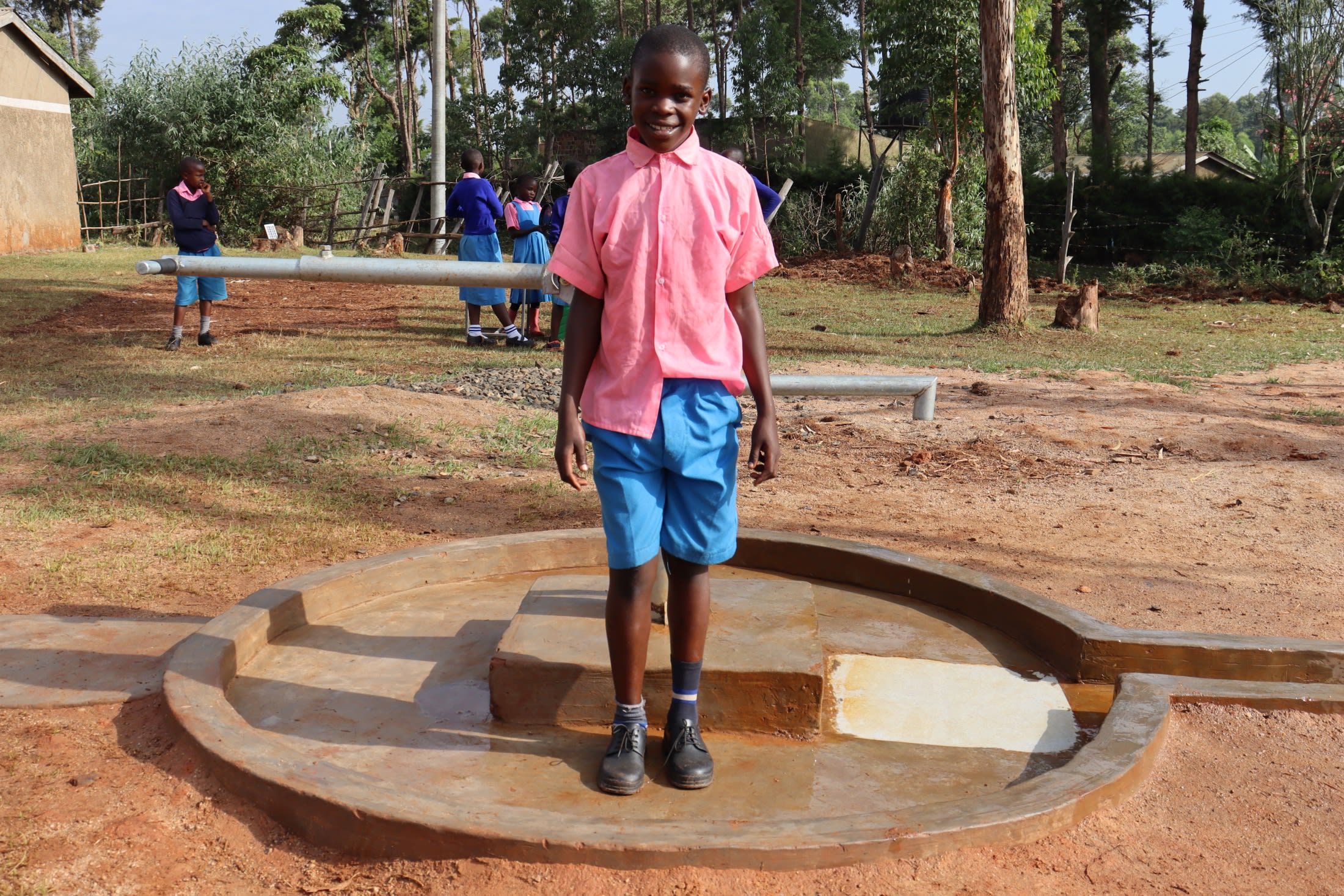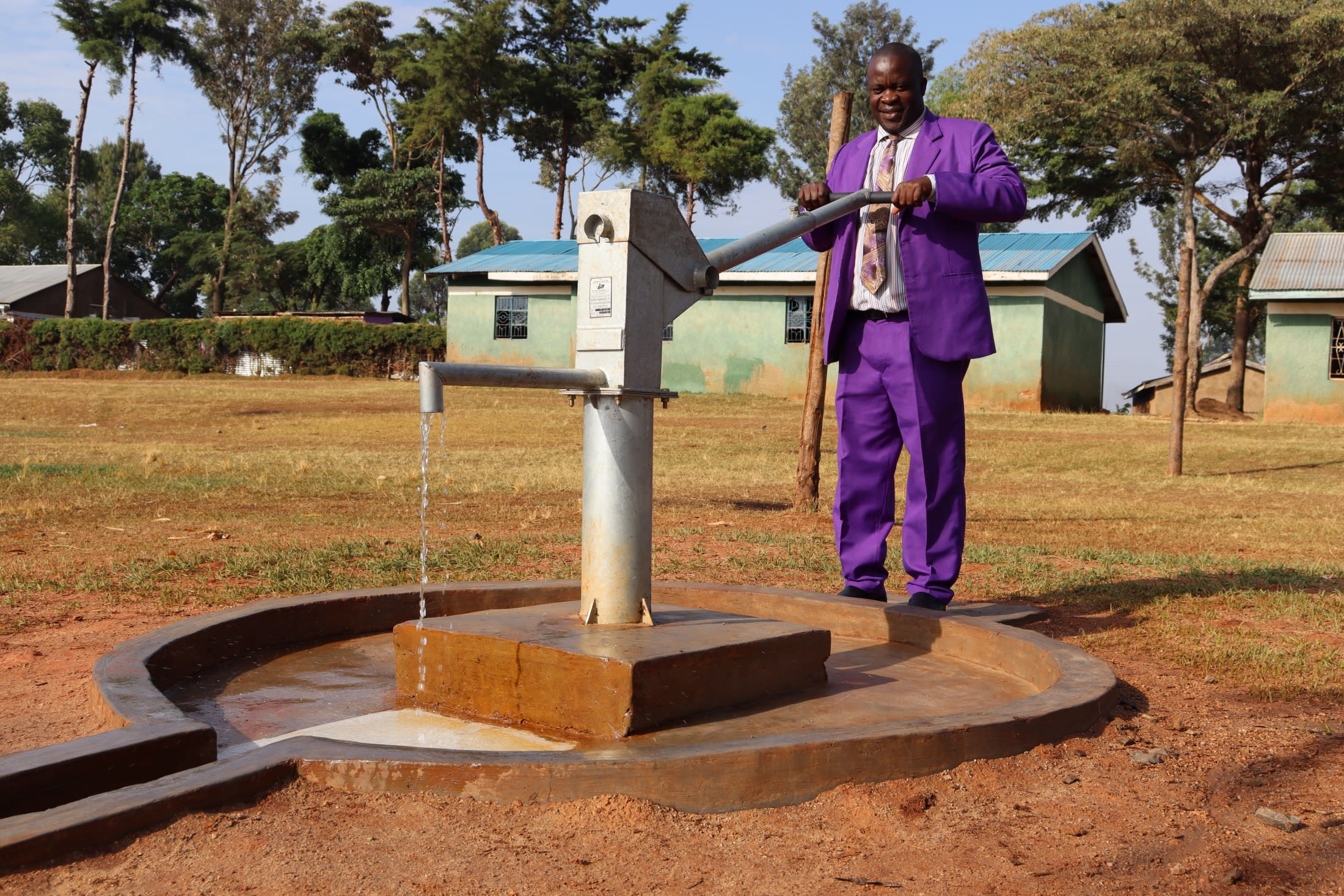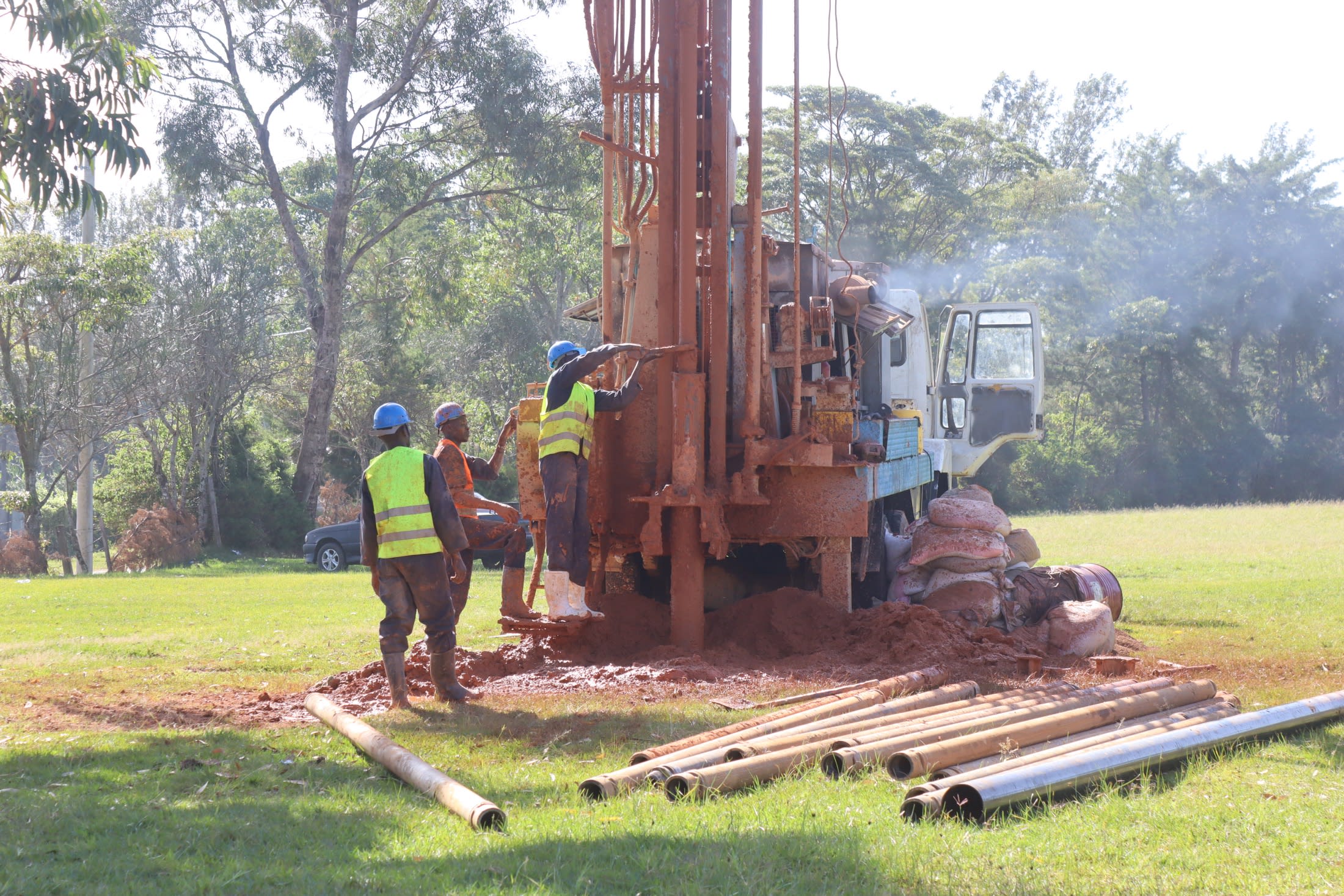March, 2023: Gisambai Primary School Well Complete!
We are excited to share that Gisambai Primary School in Kenya now has access to a new, safe, clean water source thanks to the completion of their new borehole well! Students and staff are already using the well’s flowing water, which will provide them with a reliable source of water for all of their daily needs.
We also installed new latrines and handwashing stations and trained students and staff on improved sanitation and hygiene practices. Together, these components will unlock the opportunity for these students to live better, healthier lives.

"We now enjoy clean, safe sufficient water directly in the school compound thanks to The Water Project. Our health standards will never be compromised at all. We will be able to enjoy clean, safe water for drinking," said 12-year-old Lucky I.
 Lucky continued: "For a long time now, we have had a big challenge in accessing clean, safe water for use in school. We were forced to collect water out of the school compound in a nearby community spring. Sharing the spring with the community was a big challenge, especially during the drought season when it faced congestion. We wasted time and sometimes got injured in the process of collecting water."
Lucky continued: "For a long time now, we have had a big challenge in accessing clean, safe water for use in school. We were forced to collect water out of the school compound in a nearby community spring. Sharing the spring with the community was a big challenge, especially during the drought season when it faced congestion. We wasted time and sometimes got injured in the process of collecting water."
Teachers were just as excited as the students about the new well on campus.
"With sufficient, clean, reliable water, our health standards will never be compromised in any way. Water being clean, we will be able to have clean water for drinking at any given time of need. Cases of diseases such as diarrhoea, typhoid, and other water-related diseases will drastically be reduced," said deputy teacher Hassan Mirozo.

Mr. Mirozo pumping water.
"Water being collected directly in the school compound, there will be a reduced amount of time needed to gather water. Thus more time will be better used to teach students in class," he concluded.
How We Got the Water Flowing
Parents, staff, and students all played a part in this well’s success. After determining the best site for the well through a hydrogeological survey, we obtained approval and a license from the government to begin drilling.
To prepare, the school collected fine sand and water for cement-making. When everything was ready, and the students went home from class for the weekend (drilling is very loud!), our drill team and staff arrived at the school to begin work.

Groundbreaking.
Drilling commenced with excitement in the air. The team drove down a temporary casing to keep the walls from collapsing as the rig progressed. We continued drilling to reach a final depth of 82 meters with a final static water level of 28 meters.
The drilling process can take up to three consecutive days to complete due to this region’s hard bedrock, so the drill team set up a camp where they could rest and refuel. The school’s kitchen staff and parents helped provide meals for the team, while the school provided a safe place for the artisans’ accommodations and materials.

Once we reached the required depth, the team replaced the temporary casing with a permanent version, then bailed out the dirty water at the bottom of the well. The workers installed pipes, flushed them, tested the well’s yield, and chlorinated the water.
After water treatment, we constructed a cement well pad to seal off the well from any ground-level contaminants. Tiles are installed beneath the spout to protect the cement from the erosive force of the water.

We also included a short drainage channel to carry spilled water away from the pump and prevent standing water. A soak pit absorbs runoff at the end of the drainage channel, further eliminating any stagnant water.
When the well pad was dry, we installed a new stainless steel AfriDev handpump and sampled the water for a quality test. The results showed this water was safe for drinking!

When the students and teachers arrived back at school, their enthusiasm for this much-anticipated project was overwhelming. We officially handed over the new borehole to the school.
"A representation of board members, teachers, and students assembled at the site for the handing over ceremony. A vote of thanks was made by Mr. Aggrey, the board chair, who then welcomed the headteacher to wrap it up with a thanksgiving prayer," said field officer Samuel Samidi.

Students and staff celebrated the presence of clean water on campus. The event was an excellent chance to acknowledge the school administration and students as the primary parties entrusted with the tools we have given and remind them of our continued support as they develop. Happiness, thanksgiving, and appreciation were the order of the day, flowing in all directions.
VIP Latrines

This project funded the installation of six new ventilated improved pit (VIP) latrines. These new latrines have cement floors designed to be easy to use and clean, locking doors for safety and privacy, and vents to keep air flowing up and out through the roof. With a well right on school property, there should be enough water to keep them clean.
Handwashing Stations

We set up two handwashing stations outside the latrines and handed them over to the newly formed student health club. Health club members will teach other students how to wash their hands at the stations properly, fill the stations with water, and ensure that there is always a cleaning agent available.
New Knowledge
We scheduled hygiene and sanitation training with the school’s staff, who ensured that the training date would be convenient for pupils and teachers. When the training day arrived, facilitators Rose and Samuel deployed to the site to lead the event. 22 students and teachers attended the training, which we held under some shade trees in the school compound.

Our training covered several topics, including personal hygiene, oral hygiene, the ten steps of handwashing, environmental hygiene, child rights, leadership, and operation and maintenance of the well and pump, latrines, and handwashing stations.
Students elected their peers to lead their student health club during the leadership session. Members will encourage good health and hygiene practices amongst their peers, teachers, and the larger community. By the end of the training, each pupil understood their role in sustaining clean water and good health within their school community.

The dental hygiene session was interesting and informative. The facilitator educated participants on proper dental care and encouraged them to brush their teeth after every meal to keep them strong and healthy. During the training, it was discovered that most participants used years-old toothbrushes. The facilitator encouraged everyone to replace them every three months for the best results.
Students also especially enjoyed the soap-making session. They were curious and attentive as they learned the proper steps and reagents used to make soap. The process was lively as each participant stirred the liquid mixture, and they were all delighted by the final results.

"Sanitation and hygiene training is key to survival and health. Today's training has laid much emphasis on importance of observing good hygiene and sanitation standards. We will pass this information to the community so that we be able to raise a healthy community," said 14-year-old student and the student water committee secretary Lavin K.
Conclusion
This project required a substantial collaboration between our staff, our in-country teams, and the community members themselves. When an issue arises concerning the well, the students and teachers are equipped with the necessary skills to rectify the problem and ensure the water point works appropriately. However, if the issue is beyond their capabilities, they can contact their local field officers to assist them.
Also, we will continue to offer them unmatchable support as a part of our monitoring and maintenance program. We walk with each community, problem-solving together when they face challenges with functionality, seasonality, or water quality. Together, all these components help us strive for enduring access to reliable, clean, and safe water for this community.
With your contribution, one more piece has been added to a large puzzle of water projects. In our target areas, we’re working toward complete coverage of reliable, maintained water sources within a 30-minute round trip for each community, household, school, and health center. With this in mind, search through our upcoming projects to see which community you can help next!
Thank you for making all of this possible!



 Borehole Well and Hand Pump
Borehole Well and Hand Pump
 Rehabilitation Project
Rehabilitation Project















 Lucky continued: "For a long time now, we have had a big challenge in accessing clean, safe water for use in school. We were forced to collect water out of the school compound in a nearby community spring. Sharing the spring with the community was a big challenge, especially during the drought season when it faced congestion. We wasted time and sometimes got injured in the process of collecting water."
Lucky continued: "For a long time now, we have had a big challenge in accessing clean, safe water for use in school. We were forced to collect water out of the school compound in a nearby community spring. Sharing the spring with the community was a big challenge, especially during the drought season when it faced congestion. We wasted time and sometimes got injured in the process of collecting water."
























